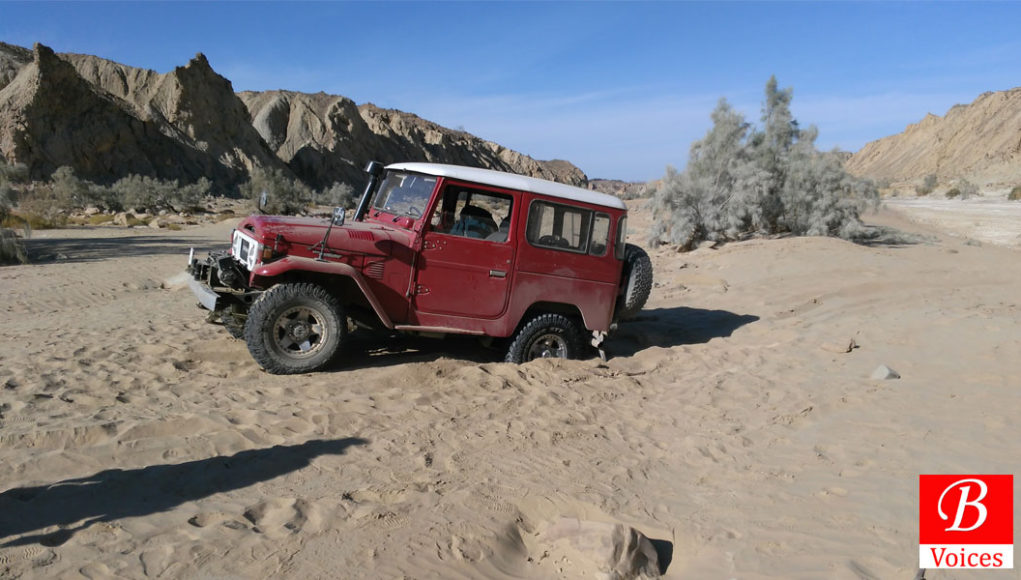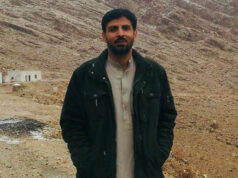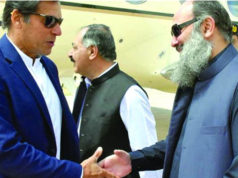Aziz Ahmed Jamali
Although I had worked over a year on a post-earthquake project in Awaran, my quest to explore the district was yet to be satisfied when I visited Tirranch a second time, last December. Tirranch, in Jhaoo Tehsil, forms the North-Eastern corner of Hingol National Park, the largest national park of Pakistan. Representing just 300 households, it spreads across three districts, namely, Awaran, Gwadar and Lasbela.
The idea of tracing tracks between Awaran and Nani Mandir floated unfulfilled in my mind until Aqeel Baig, my adventurous friend from Karachi, offered to tag along. By the time we finalized the dates of our visit, Balochistan Forest Department officials happily joined us; and Sohaib Ali, another jeep owner agreed to venture in all the way from Quetta. Meanwhile, my younger brother Feroz and nephew Danyal (Dani) were already searching for a spree. Azam Khan accompanied Sohaib and I from Quetta, Dr Yaqub Lasi joined from Bela, Abdul Qadir from Hingol and Abid Ali as District Forests Officer Awaran. Aqeel Baig brought along Camran Mir, another motorist. Makbool Durrani (Mac) also crept out of his Clifton, Karachi hideout.
We embarked from Circuit House Uthal in three vehicles. Camran Mir kept lamenting why he didn’t bring Mutt, his jeep which we didn’t know had become his last love. It was later revealed that since his jeep was a bit weaker than others and his family quite well off, Camran couldn’t praise Mutt as his ‘first love’ at home; hence he would vent positive praise of Mutt every ten minutes on any outdoor journey.
Beginning with camera clicks and videos right from the Bela – Awaran Road, and the peculiar passage through the mud hills of Jhaoo Luck, we stopped briefly near the shrine of Shirin & Farhad, lovers of a mythical folk tale. Mama Marri, an iconic and old funny figure was to join us that day. We awaited him at Goko Check Post, but when he couldn’t make it on time, we proceeded on the bumpy jeep track by turning south, off the main road. Our destination was five hours away on a bumpy road along the Babro Kaur (stream), a tributary of the Hingol River. However, fun with mud hills and the sand’s tricks with our jeeps engaged us enough; hence we reached Tirranch around midnight. Dead tired, only one thing could keep us awake in that mud-made abandoned school building that night: mutton curry (of a whole lamb) which Mulla Abdul Rehman cooked for us in an hour.
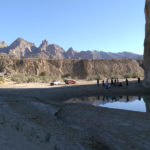
Our first night was as comfortable as it could be in villages of wilderness anywhere. Around dawn of the next day, each one of us kept locating a ‘washroom’ in the vast, Mars-esque terrain of Tirranch. Those who actively contributed in the search and collection of firewood seemed more satisfied, proud in knowing the ups and downs, like Alexander’s soldiers years ago. Few things that could be of some significance in the village of Seri Tirranch are Mulla Abdul Rehman (one can’t arrange food without him), the old remains of a stone-made colony (shows as if an army lived there for a considerable period of time) and a makeshift mud-bricked school whose government appointed teacher’s absence had made it abandoned for the 30 kids who could possibly read something about the world, if activated. Having appreciated, praised and discussed all of the above significances, we began our journey further and after driving an hour, stopped at Cheri Tirranch, the next village towards the south. Another makeshift school greeted us along the main road but this looked more promising than the one before. About 25 boys and girls were chanting in the presence of a volunteer teacher standing as their leader. It was the 25th of December, a public holiday in Pakistan, yet that made little difference to those in Tirranch, the teacher told us; he opened the school mindful of the apprehension that a visiting official from the Education Department might surprise them by coming in the garb of a trekker. Appreciating his efforts, we moved further along, taking along 60 year old Nako Hussain as our guide for the journey ahead and rushed to Akhri Tirranch, the southern terminal in the district of Awaran. There, we had to part with our jeep driving friends (sweetest fellows) and set out on foot in Hingol National Park.
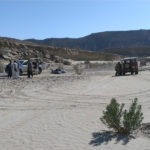
An idea that bubbled was exploring a jeep track from Tirranch, in Northern Hingol, to Southern Hingol; but it was subdued by Nako Hussain telling us that the passage of any jeep via the Pacherri Pass and stream had been made impossible due to recent rains. Camran Mir, naturally, felt confident about Mutt. Not being able to afford time on ‘making’ a way out, we decided on the day-long detour; and asked our jeeper friends to take a long round via Bela, on the Makran Coastal Highway and receive us near Pol Daat in Southern Hingol. Hussain slaughtered another goat before leading us on the long walk along Reki Kaur, another tributary of Hingol known as Hodar Kaur (in its western terminal). We enjoyed a brief exploratory visit of interesting rock formations at Akhri Tirranch; that alluring terminal of Reki Kaur. A gorge with tall stone walls offering passage only for one person at a time in certain places; then wide open vistas of virgin beauty with interesting rock shapes and wild plants including ferns and figs. It’s an ideal place to establish a shrine of solace for devotees who like to travel long distances in order to have their heart’s desires fulfilled.
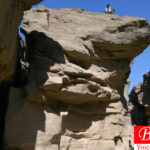
The trek from Tirranch till the Hodar terminal of Hingol River became the most memorable part as we listened to music of sorts in the form of screaming calls, ‘Stop for one moment please!’, ‘Who the hell said this was a trek’, and some mid course corrective information (Nako Hussian telling us that the village near Hodar is only 20 minutes away while those 20 minutes would never materialize). It took us four hours to walk across Hodar Stream and another four hours to comprehend the last 20 minutes Hussain kept telling us about. However, the journey did let us enjoy views of Tirranch from the few tall, towering rock features in gorges around and a couple of water bodies that we couldn’t afford drinking (Meetha paani kia marne ke baad milay ga?!/will we get freshwater after we die?!) Around 10PM, after walking two hours in the moonlight, we camped near Dandail, the Hingol terminal of Hodar Stream, and slept immediately after dinner.
Friends, and now readers, are evidence that I didn’t discuss Dani; he knows how he made his first ever trekking expedition ‘possible’. Traversing those 18+ kilometers was so tough that even I had to ask Azam Khan to help me carry my rucksack, while Camran Mir couldn’t speak about anything beyond Mutt.
While we made the journey in one long day on foot, our jeeper friends wouldn’t reach Dandail until next afternoon. Hence we explored some Hingol terrain the next day. After a brief breakfast, and discussion on ‘possible’ and ‘successful’ missions (this goes with a confidential reference to Mac), we set to see villages near Pol Daat. A two hours walk on the Larragi plane (a small Hobara Bustards habitat), brought us to the Hingol River, the region’s lifeline. We stopped to watch a few glimpses of marsh crocodiles; and then couldn’t resist jumping in the water to relish a mud bath (Here we would like to thank the crocodiles who didn’t have us for lunch). Refreshed, we walked another hour to Sardu’s village short of Pol Daat and devoured another lamb. Hospitality of the Baloch seemed disproportional to their economic conditions. Not only were we hosted with food and hot drinks, three camels were immediately saddled to carry us back. The camel ride however, was a bit too adventurous for us novices, hence most of us dismounted within an hour and preferred to walk the remaining distance. Only Dani and Camran, the heaviest Homo Sapiens in our group, persevered. Unfortunately, we couldn’t seek the animal’s opinion on the subject.
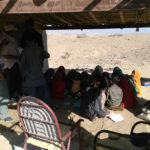
By the time we returned from Pol Daat to Dandail in the afternoon, our jeeper friends had already reached and were searching around as if we were the ones lost. Meeting them was most joyous indeed. Hugs and photographs ensued and we then put our efforts into pulling and pushing Sohaib’s jeep, which had fallen in love with Dandail and refused to leave. In the end, we had to convince it through some mechanized pulling, via Aqeel Baig. Traversing the Hingol River, after we crossed the bridge near Nani Mandir (Hinglaj Mata Temple), the Forest Department vehicle went quiet just before their own departmental check post on the Coastal Highway. Once again it was towed a few kilometers to reach the Hingol National Park (HNP) office at Agore, which was to be where we would spend the night.
The Forest Department and Park Management quickly arranged another roast lamb feast, and led us on a soothing walk by the Kund Malir beach under bright moonlight. The night was spent in well furnished rooms. Early next morning, recharged with hot cups of tea and loaded with gifts and souvenirs from the department and park management, we left for our respective homes. Thus came to an end our four day saga between Shirin Farhad and Hinglaj Mata, a most memorable trip.
Courtesy Series:
Jeeps – Aqeel Baig and Sohaib Ali Baloch
Cameras – All especially Aqeel, Dr Yaqub and Makbool Durrani
Knowledge Group – Abdul Qadir Jamali and Abid Ali, officers of Forest & Wildlife Department, Balochistan
Missed: Hafeez Baloch and Hanif Bhatti, our like-minded fellows
Writer is an officer of Pakistan Administrative Servcies
Share your comments!


